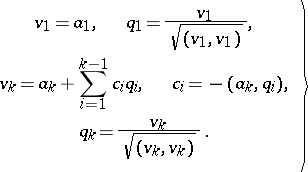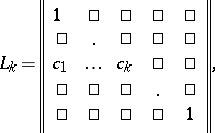Difference between revisions of "Orthogonalization method"
(Importing text file) |
m |
||
| Line 1: | Line 1: | ||
| + | {{TEX|want}} | ||
| + | |||
A method for solving a system of linear algebraic equations <img align="absmiddle" border="0" src="https://www.encyclopediaofmath.org/legacyimages/o/o070/o070430/o0704301.png" /> with a non-singular matrix <img align="absmiddle" border="0" src="https://www.encyclopediaofmath.org/legacyimages/o/o070/o070430/o0704302.png" /> based on the Gram–Schmidt method of [[Orthogonalization|orthogonalization]] of a vector system. | A method for solving a system of linear algebraic equations <img align="absmiddle" border="0" src="https://www.encyclopediaofmath.org/legacyimages/o/o070/o070430/o0704301.png" /> with a non-singular matrix <img align="absmiddle" border="0" src="https://www.encyclopediaofmath.org/legacyimages/o/o070/o070430/o0704302.png" /> based on the Gram–Schmidt method of [[Orthogonalization|orthogonalization]] of a vector system. | ||
Revision as of 17:23, 1 June 2013
A method for solving a system of linear algebraic equations  with a non-singular matrix
with a non-singular matrix  based on the Gram–Schmidt method of orthogonalization of a vector system.
based on the Gram–Schmidt method of orthogonalization of a vector system.
If
 |
 |
 |
 |
then the initial system of equations can be written in the form
 |
This means that the solution of the system is equivalent to the determination of a vector  which has 1 as the last component and is orthogonal to all vectors
which has 1 as the last component and is orthogonal to all vectors  ,
,  . For this purpose, an orthogonalization process is used for the vector system
. For this purpose, an orthogonalization process is used for the vector system  , where
, where  , which is linearly independent by virtue of the non-singularity of the matrix
, which is linearly independent by virtue of the non-singularity of the matrix  . This process entails the construction of an orthonormal vector system
. This process entails the construction of an orthonormal vector system  , with respect to the scalar product
, with respect to the scalar product  , using the recurrence relations
, using the recurrence relations
 | (*) |
The coefficients  are obtained from the condition of orthogonality of
are obtained from the condition of orthogonality of  to the vectors
to the vectors  . The vectors
. The vectors  are linearly expressed in terms of
are linearly expressed in terms of  , so the vector
, so the vector  is orthogonal to all vectors
is orthogonal to all vectors  . The non-singularity of
. The non-singularity of  ensures moreover that
ensures moreover that  . Thus,
. Thus,
 |
is the required solution of the system.
This scheme of the orthogonalization method fits well into the general scheme of direct methods for solving a system: The relations (*) are equivalent to the transformation of the matrix of the system to the matrix  , where
, where
 |
and thereby realizes a factorization of the matrix of the system in the form  , where
, where  is a triangular and
is a triangular and  a unitary matrix.
a unitary matrix.
The process of factorizing a matrix  by means of the orthogonalization method is stable for rounding errors. If in (*), when the operation of taking the scalar product of vectors is carried out, a procedure of accumulation with double precision is used, then for the factorization of the matrix by means of the orthogonalization method one of the best estimates of accuracy in the class of direct methods is obtained. In this case, however, the property of orthogonality of the vectors
by means of the orthogonalization method is stable for rounding errors. If in (*), when the operation of taking the scalar product of vectors is carried out, a procedure of accumulation with double precision is used, then for the factorization of the matrix by means of the orthogonalization method one of the best estimates of accuracy in the class of direct methods is obtained. In this case, however, the property of orthogonality of the vectors  , i.e. the property that
, i.e. the property that  is unitary, is unstable in relation to rounding errors. So the solution of the system obtained from the recurrence relations (*) can contain a large error. To eliminate this deficiency, various methods of re-orthogonalization are used (see [1], [2]).
is unitary, is unstable in relation to rounding errors. So the solution of the system obtained from the recurrence relations (*) can contain a large error. To eliminate this deficiency, various methods of re-orthogonalization are used (see [1], [2]).
The speed of operation of the orthogonalization method is inferior to that of many direct methods.
References
| [1] | V.V. Voevodin, "Computational foundations of linear algebra" , Moscow (1977) (In Russian) |
| [2] | N.S. Bakhvalov, "Numerical methods: analysis, algebra, ordinary differential equations" , MIR (1977) (Translated from Russian) |
Orthogonalization method. Encyclopedia of Mathematics. URL: http://encyclopediaofmath.org/index.php?title=Orthogonalization_method&oldid=29814